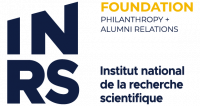
This award recognises my work and efforts throughout my master’s degree. I would like to thank all the people who have contributed in any way to the success of my academic career so far. This prize reaffirms the relevance of my research area and is also a source of motivation for the rest of my research career.
Lilian Skokan
M.Sc. energy and materials sciences, 2022
Centre Énergie Matériaux Télécommunications
Supervisor: Andreas Peter Ruediger
2023 Best master’s thesis award
Lilian Skokan's dissertation highlights the multidisciplinary aspect between materials science and forensic science and is the result of a unique collaboration, as it has applications in the field of public safety worldwide. Her work on the reconstruction of obliterated serial numbers in polymers is the result of the optimisation of optical methods for the analysis of alphanumeric characters engraved in firearms by mechanical force and altered as a result of criminal activity. The quality of her work has been awarded an “Excellent” mention.
What brought you to INRS? What do you take away from your experience?
During my bachelor’s degree in chemistry (forensic profile) at the Université du Québec à Trois-Rivières, I had the chance to collaborate on a few occasions with Professor Cyril Muehlethaler on research projects in forensic science. It is thanks to a partnership between him and Professor Andreas Ruediger (now my principal supervisor) that I came to know INRS and that my master’s project was born. It was my inquisitive nature and my passion for the study of traces related to criminal activities that led me to pursue my research career at INRS.
INRS and my supervisor provided me with a learning environment characterized by access to state-of-the-art equipment and multiple opportunities to collaborate with students from the Centre Énergie Matériaux Télécommunications and other universities. I was also able to undertake a few international research visits and participate in conferences (both local and international). I had the chance to interact with scientists from different fields and cultural backgrounds.
My role as a graduate student allows me to use my scientific knowledge while having some autonomy and creativity.
Can you describe the challenge and impact of the research presented in your thesis?
The mass production of polymers worldwide has forced forensic science practitioners to study new types of traces and objects. For example, ballistics experts may now be confronted with cases of restoration of serial numbers on firearms made partially or entirely of polymer. These alphanumeric characters can provide valuable information for investigative purposes, specifically in leading to the identification or individualisation of the firearm in question, hence the relevance of their restoration. As these numbers are traditionally introduced by stamping methods (mechanical force), the local deformations caused by the introduction of the characters into the polymer are exploitable by optical methods despite the surface abrasion that may result from criminal activity.
My master’s project focused on the development of a non-destructive technique (i.e. one that allows the serial number to be preserved in its original state), exploiting the interaction between laser and material, to characterise the vibratory profile of the molecules making up polymers. This allows me to construct maps showing visual contrasts between the stamped and unstamped portions of polymeric samples, despite the alteration of the serial number which generally makes it invisible to the naked eye.
My thesis is the result of a novel collaboration between materials science and forensic science and has application in the field of public safety worldwide.
What does winning this award mean to you?
This award recognises my work and efforts throughout my master’s degree. I would like to thank all the people who have contributed in some way to the success of my academic career so far. This award reaffirms the relevance of my subject and is also a source of motivation for my future research career.
What is the next chapter for you now that you are graduating?
I am currently a student in the PhD programme in energy and materials sciences at INRS (expected to finish in autumn 2025). I am pursuing the study of local deformations within non-metallic structures (such as polymers) with an interest in other objects of interest in forensic science, for example, 3D printed guns and plumbing pipes. My dissertation supervision is still provided by Professors Andreas Ruediger (INRS) and Cyril Muehlethaler (UQTR).
